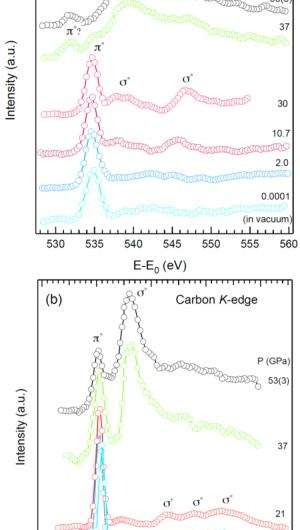Carbon dioxide study adds to picture of global carbon cycle

(Phys.org) —One of the most widely known compounds on Earth is carbon dioxide, or CO2. We learn as children that CO2 is a key component of photosynthesis, the process by which plants, algae, and bacteria convert light into energy. This reaction is part of the global carbon cycle, the exchange of carbon between Earth's land, oceans, and atmosphere – and is key to our planet's ability to support life.
But despite the fundamental importance of CO2, scientists are still learning some basic information about it, such as the details of its behavior under extreme pressures like those found deep within Earth. These details are vital to understanding the carbon cycle, as well as the evolution and dynamics of our planet's interior.
Recently, the results of an x-ray study to investigate the structure of CO2 under high pressures, performed by an international research team led by Sean R. Shieh of the University of Western Ontario and Ignace Jarrige and Yong Cai from Brookhaven National Laboratory's Photon Sciences Directorate, were published in the November 12 edition of the Proceedings of the National Academy of Sciences. The team reports that CO2 transitions into an "amorphous polymorph," a solid phase of matter without long-range order, at a much lower pressure than previously thought.
"This is the first evidence of the formation of amorphous CO2 at such low pressures at room temperature," said Ignace Jarrige. "Because the amorphous phase is a precursor to the superhard crystalline phases that form at higher pressures, understanding it is essential to creating a full picture of the global carbon cycle."
While previous studies report a transition near 50 gigapascals (GPa), the team observed that the transition to the amorphous phase takes place at a pressure of 37 GPa (corresponding to about 560 miles below the Earth's surface), which was evidenced by the change from double carbon-oxygen bonds (the atoms share two pairs of electrons) into single bonds (they share one pair).
Additionally, prior studies of CO2 have left unresolved questions about the "coordination number" of the carbon atom – the number of atoms it is bonded to. Coordination number tells scientists about a molecule's electronic structure and is often used when describing materials with either short- or long-range crystal structures. In solids, a higher coordination number is an indicator of a more tightly packed, efficient arrangement of atoms.
Several coordination numbers have been proposed for carbon in amorphous CO2, all stemming from infrared studies that are not ideal for probing the electronic structure of amorphous solids. The team resolved the issue by taking x-ray scattering data on a CO2 sample as they increased the pressure up to 63 GPa. They determined that the coordination is fourfold, meaning each carbon atom has four nearest atomic neighbors. Further, the data show that some carbon and oxygen actually take the form of two short-lived species, CO and CO3, which disappear above 63 GPa.
"Our unraveling of the coordination of carbon in compressed CO2 at pressures all the way up to 63 GPa is critical to the understanding of the cycle of carbon when it reaches the far depths of Earth's interior and forms superhard phases," said Jarrige.
At Brookhaven Lab's new synchrotron facility, NSLS-II, now under construction and set to begin operating in 2015, the team is planning further studies at the Inelastic X-ray Scattering (IXS) beamline, one of seven initial beamlines being constructed. Cai, the NSLS-II IXS Beamline Group Leader, is in charge of the development, operation, and management of IXS.
"IXS will offer unprecedented energy resolution for measurements of atomic and molecular vibrations at the nanometer length scale," said Cai. "These measurements will undoubtedly contribute to the understanding of the nature of Earth's deep carbon, and will also be crucial to understanding the polymorphic transitions of materials under high pressure in general."
More information: Sean R. Shieh, Ignace Jarrige, Min Wu, Nozomu Hiraoka, John S. Tse, Zhongying Mi, Linada Kaci, Jian-Zhong Jiang, and Yong Q. Cai. "Electronic structure of carbon dioxide under pressure and insights into the molecular-to-nonmolecular transition." PNAS 2013 110 (46) 18402-18406; October 28, 2013, DOI: 10.1073/pnas.1305116110
Journal information: Proceedings of the National Academy of Sciences
Provided by Brookhaven National Laboratory



















